What is Mycoplasma in Cats?
Mycoplasma is a bacteria which causes infectious anaemia in cats. Mycoplasmosis is also known as feline haemotropic mycoplasmosis (FHM). It is a microscopic bacterial “parasite” that infects the cat’s red blood cells (RBCs). Mycoplasma in cats causes mycoplasmosis. Earlier, mycoplasmosis was known as feline infectious anaemia (FIA).
How Does Mycoplasma Affect Cats?
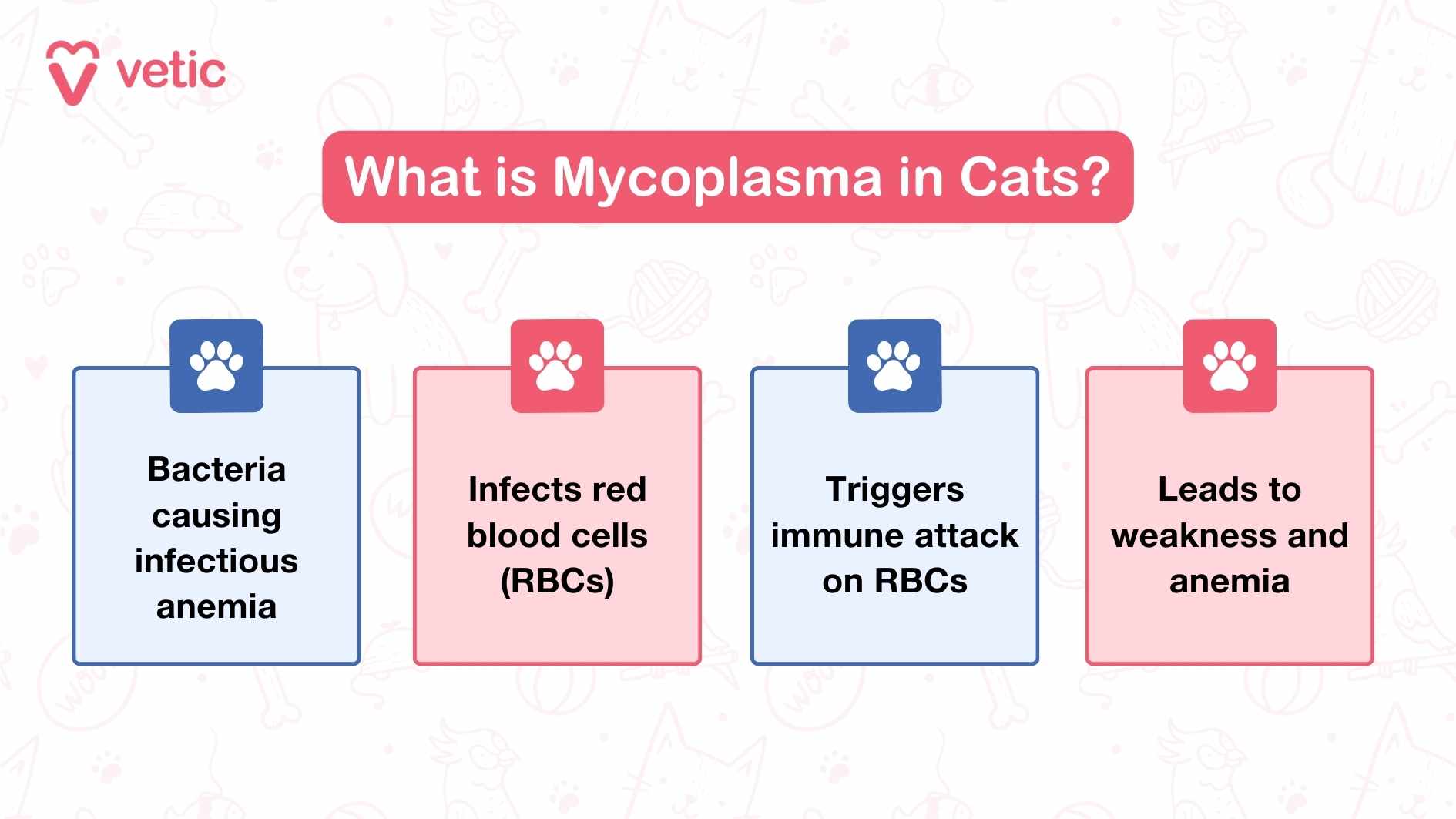
Mycoplasma haemofelis is a special type of bacteria that doesn’t have a cell wall. They can enter the red blood cells (RBCs) and continue to multiply. The cat’s RBCs become covered with mycoplasma and its immune system begins attacking and breaking the RBCs since they have foreign bodies (bateria) on them.
It causes a rapid destruction of the RBCs and their removal from the cat’s system. The coated RBCs are removed via the action of the spleen. So, even though the infected RBCs are destroyed along with the mycoplasma within them, the infected cat soon becomes weak, pale, anaemic and even jaundiced.
The rate of the destruction of the RBCs is much higher than the production of mature RBCs. That is the main cause of anaemia or Feline Infectious Anaemia (FIA) in the infected cats.
What Causes Mycoplasma in Cats?
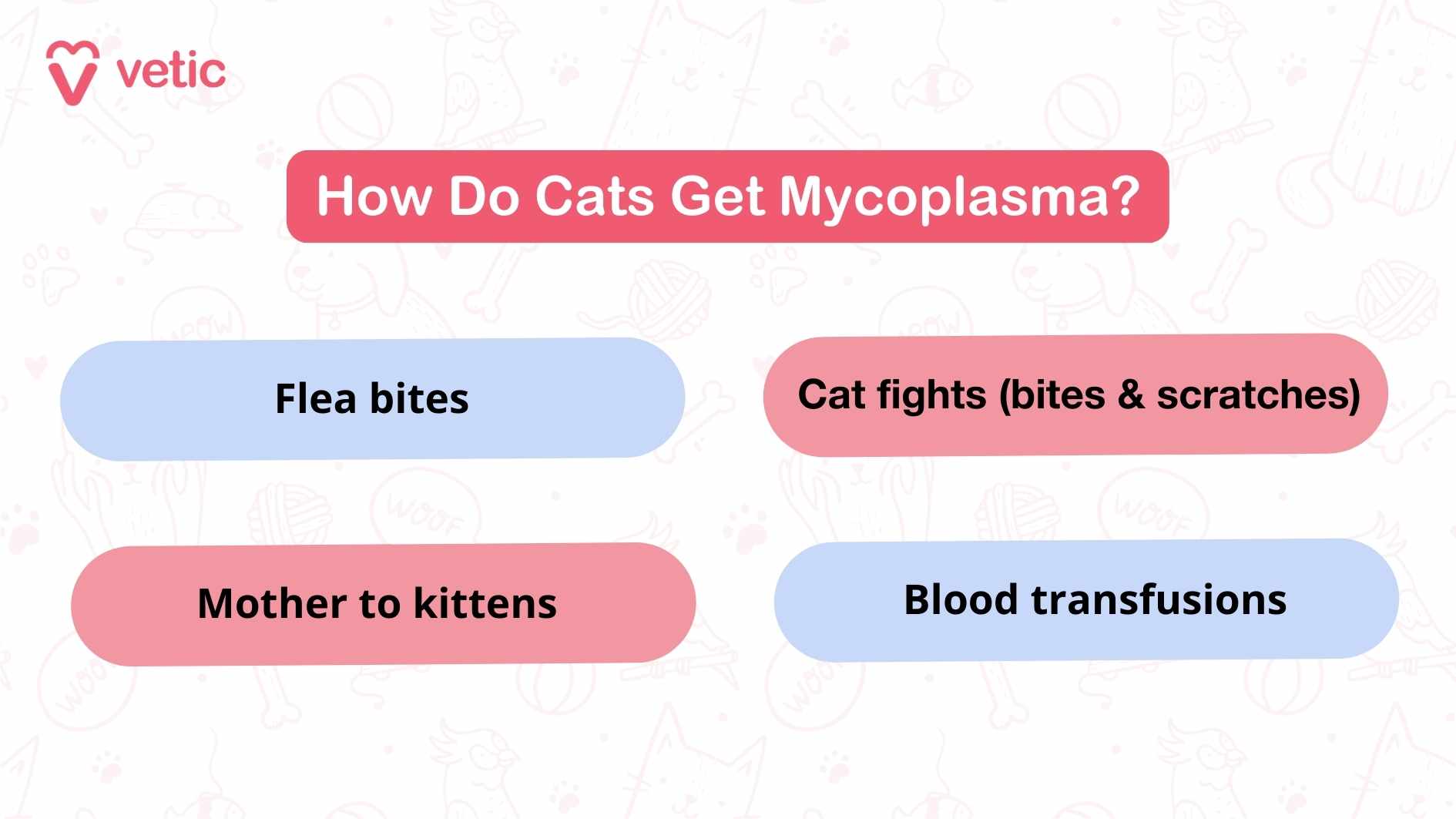
Mycoplasma in cats is transmitted via infected flea bites. The mycoplasma invades the RBCs of the cat and the cat’s immune system detects the RBCs as foreign. Once the cat’s immune system marks the RBCs they are rapidly destroyed along with the mycoplasma in them.
In simpler words, mycoplasma in cats is caused by the bite of an infected flea!
Signs and Symptoms of Mycoplasmosis in Cats
Cats with mycoplasma are often sick, weak and pale. They are anaemic and show signs like eating dirt. Mycoplasmosis in cats may cause a fever. Not all cats with feline infectious anaemia (FIA) have a fever.
So, what are the signs of mycoplasmosis in cats?
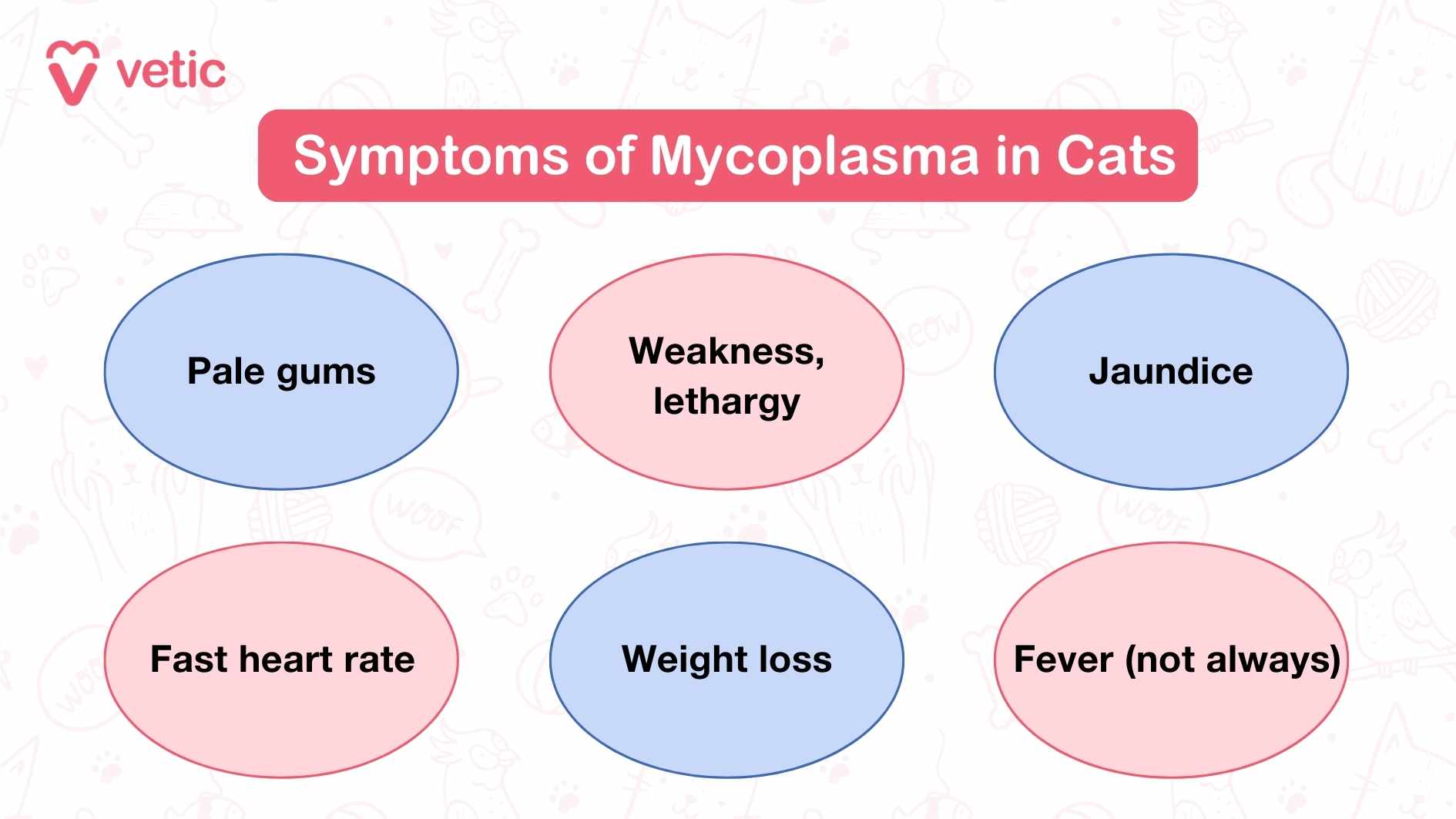
Anemia-related signs of mycoplasma in cats:
- Pale gums
- Weakness and lethargy
- Jaundice (yellowing of the skin and eyes)
- Increased heart rate
- Loss of appetite
- Weight loss
- Fever
Respiratory signs:
- Sneezing
- Nasal discharge
- Coughing
- Conjunctivitis (inflammation of the eye’s conjunctiva)
- Ocular discharge
Mycoplasmosis in cats can manifest through various clinical signs, primarily due to its impact on red blood cells (feline infectious anaemia or haemolytic anaemia).
Diagnosing Mycoplasma in Cats
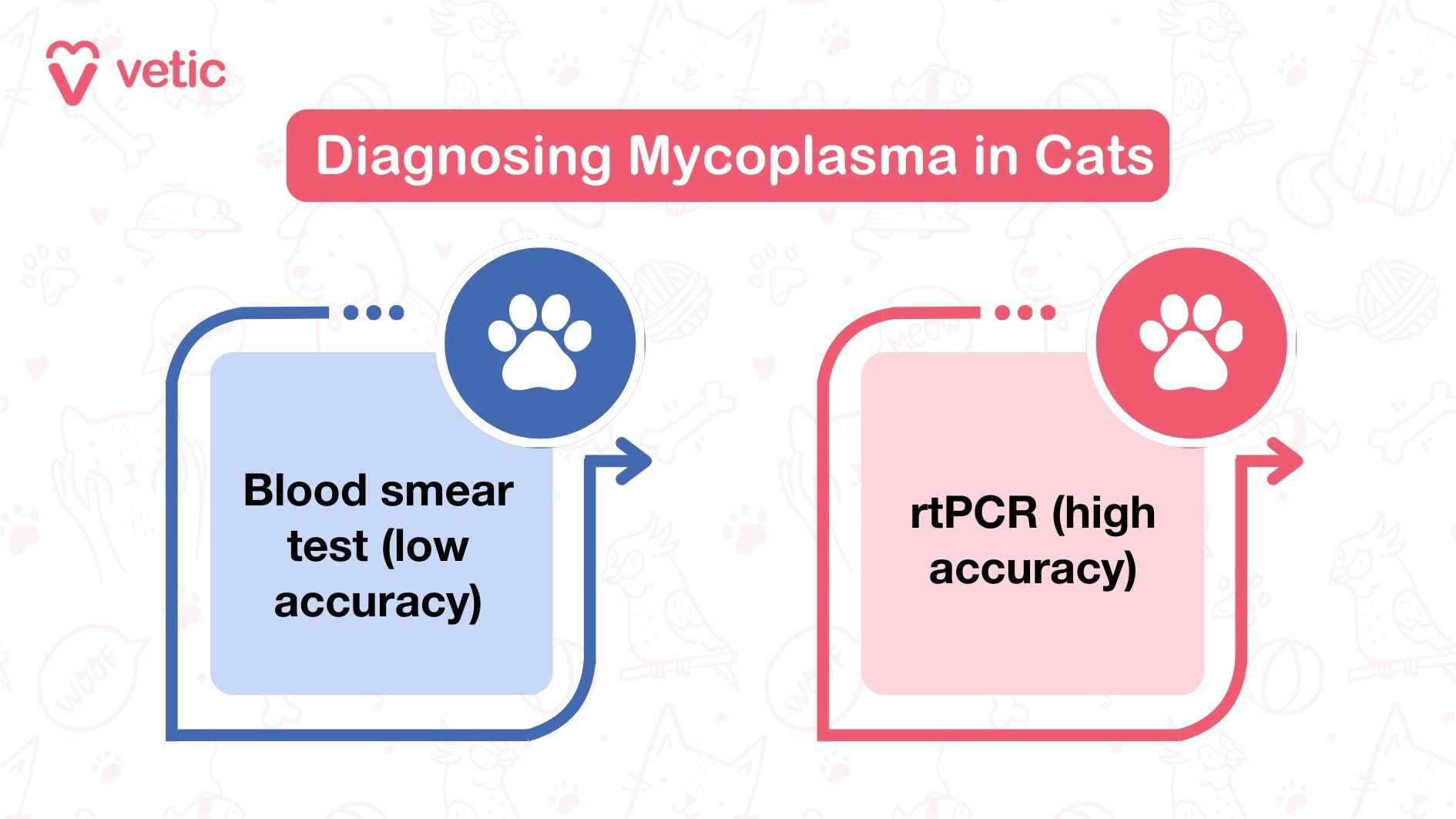
Mycoplasma in cats is diagnosed via mycoplasma cat blood smear and rtPCR along with complete blood count.
However, detecting mycoplasma in a blood sample smear is challenging. The number of visibly infected red blood cells decline rapidly within the sample.
Mycoplasma is not detectable through blood culture or complete blood count tests only since they live inside the red blood cells.
rtPCR has helped in the accurate diagnosis of mycoplasma infections in cats down to the exact species. It is a highly accurate technique that can detect even the smallest level of the infection in a cat and even distinguish between the levels of infection – mild, moderate and severe.
Complete blood count can reveal the status of immune response and the number of immature RBCs circulating in the system. It sheds light on the overall health of the infected cat and the supportive treatment required.
Since the rapid destruction of the RBCs can create significant stress on the liver and kidneys, your veterinarian will also recommend biochemistry tests including liver function tests and kidney function tests to assess organ health and function.
Is Mycoplasma in Cats Contagious?
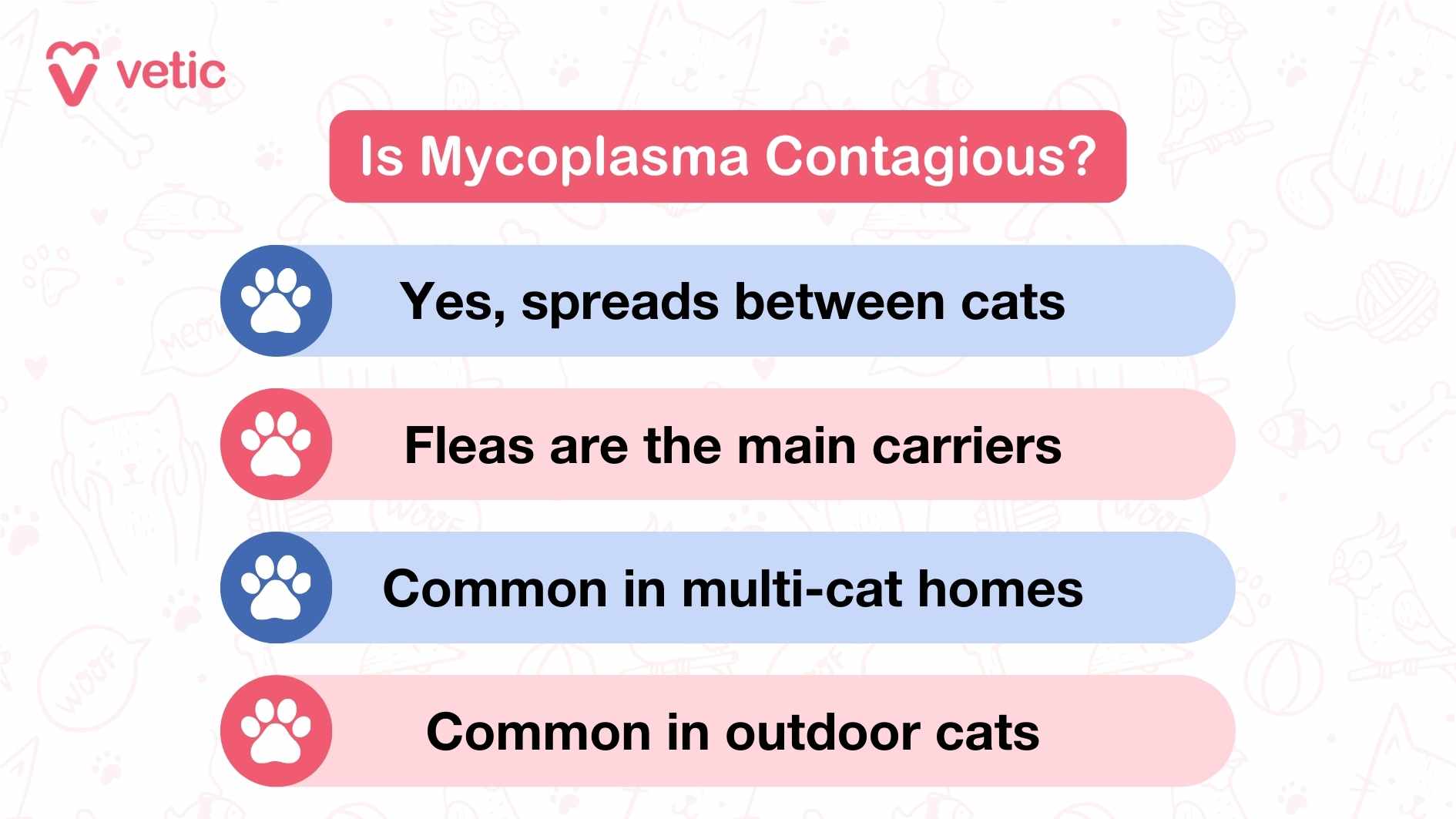
Mycoplasmosis is considered contagious since it can spread between cats. It is especially common in multi-cat households.
Mycoplasmosis in cats spreads through –
- Flea bites
- Direct and indirect contact
- From mother to kittens
- Blood transfusions
Flea bites: Mycoplasma mainly spreads through the bites of infected ticks. So, if you have an outdoor cat or multi-cat household, you need to apply flea treatment to all the cats to keep them safe.
Direct and indirect contact: Cat fights (bites and scratches), shared spaces and accessories increase the risk of mycoplasma transmission.
Mother to kittens: Mycoplasma can be transmitted from mother to kittens via fleas directly, or during pregnancy and nursing.
Blood transfusions: If an infected cat donates blood that goes to an immunocompromised cat, it can cause mycoplasmosis.
Mycoplasma Treatment in Cats
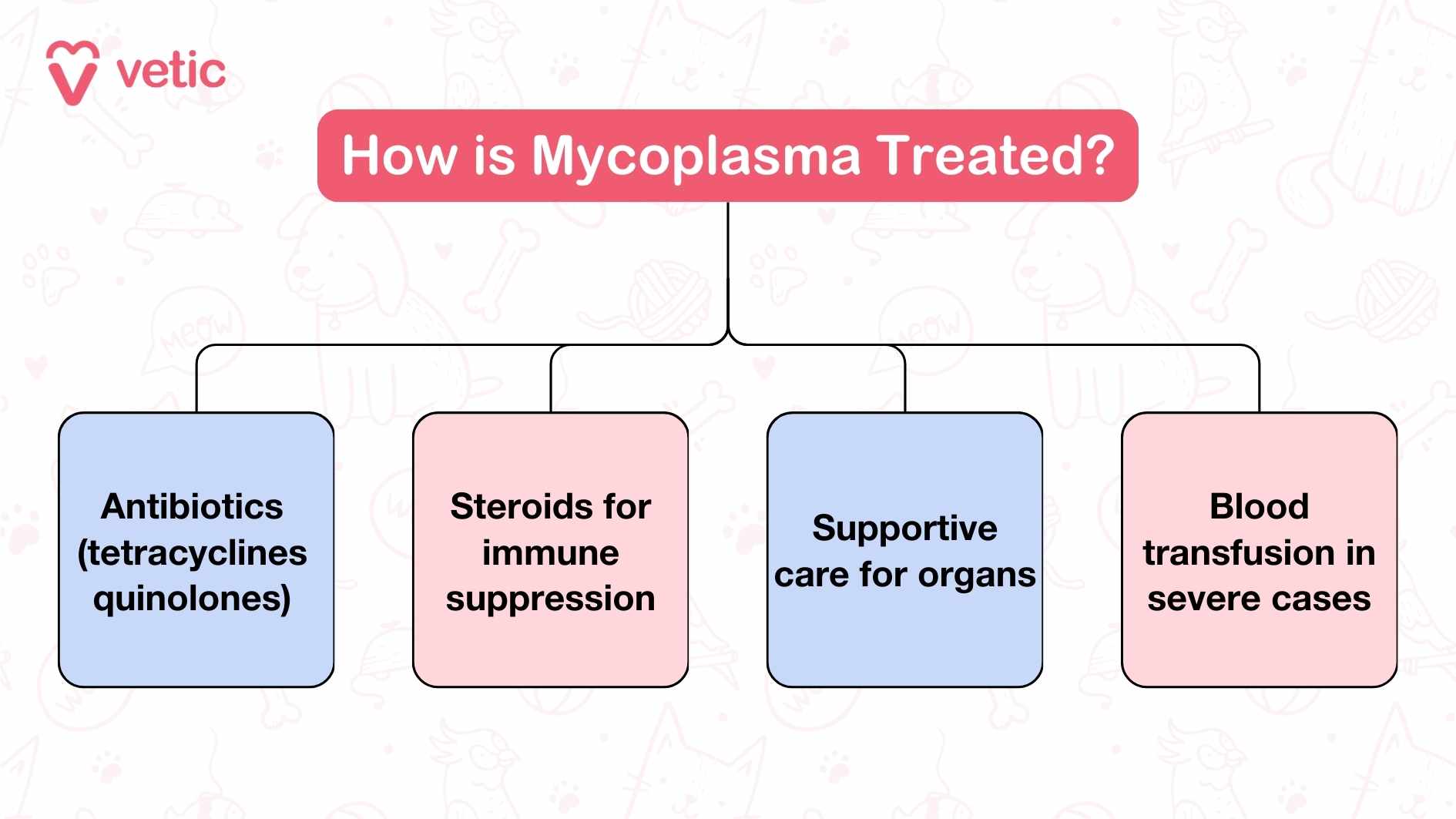
Treatment of Mycoplasma haemofelis in cats should be started immediately after confirmed diagnosis.
All mycoplasma variants are susceptible to the tetracycline group of antibiotics. However, some tetracyclines can be more damaging to a cat’s overall health, so always stick to your veterinarian’s prescribed antibiotic and doses for the treatment of mycoplasmosis.
Palatable syrups of this group of antibiotics make it easier for the treatment of mycoplasma in cats.
Studies also show that the quinolone class of antibiotics can also treat mycoplasmosis in cats. However, this group of antibiotics are not used in pregnant cats or kittens younger than 8 weeks.
The course of treatment for mycoplasmosis in cats usually lasts 3 weeks. However, supportive medication for platelet formation, inflammation, liver and kidney health may continue for longer depending on the cat’s blood and biochemistry test results.
Sometimes, veterinarians can recommend the sequential use of the tetracycline and quinolone antibiotics to clear out the infection completely.
Since the immune system of the infected cat attacks and destroys the RBCs, veterinarians may recommend a steroid or steroid hormone to suppress a part of the immune system. However, cats with feline immunodeficiency (FIV) may not respond well to this treatment.
Severely sick cats may require blood transfusions to make it through the course of the treatment.
Can Cats Survive Mycoplasma?
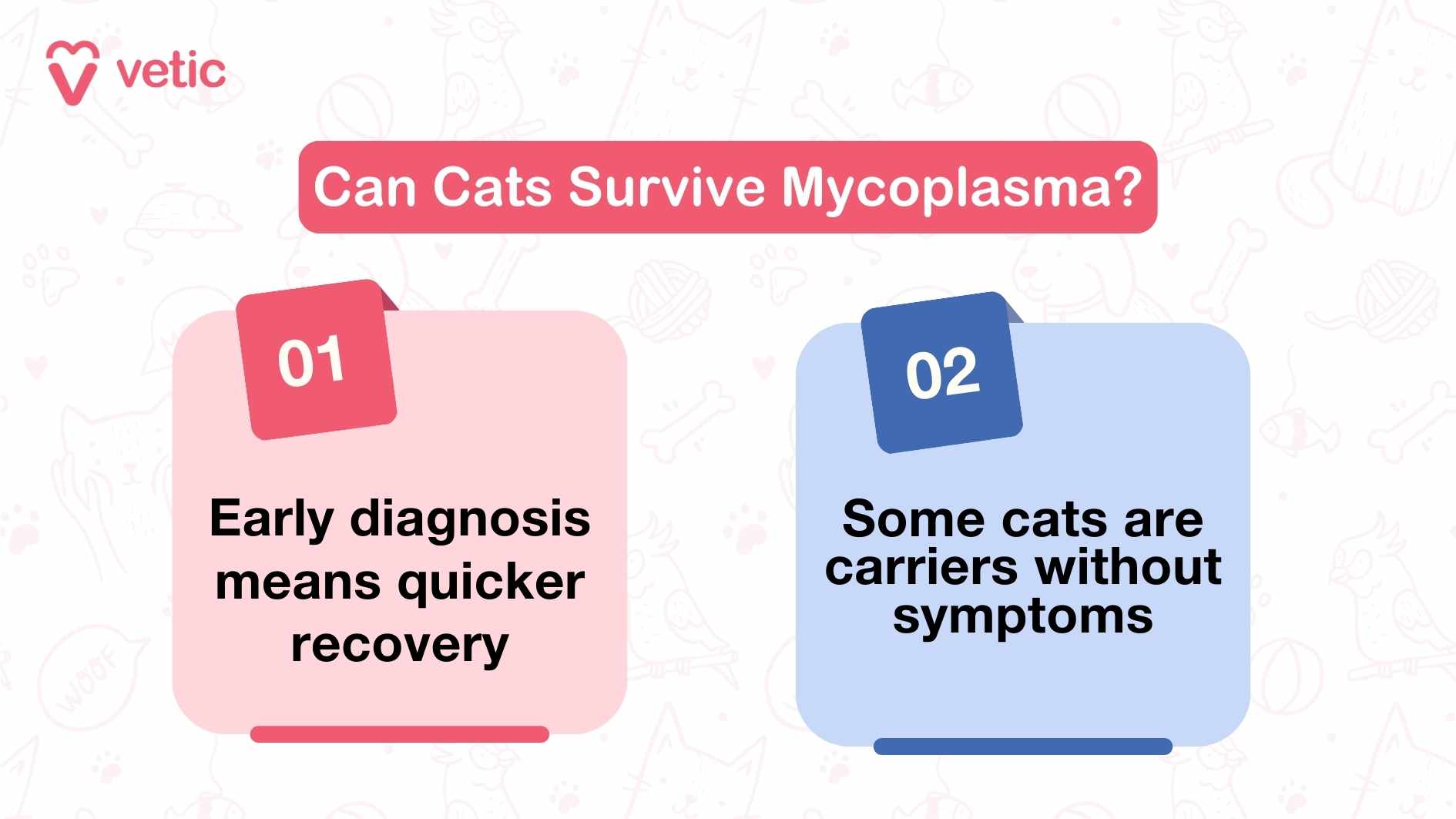
The prognosis of cats with mycoplasmosis is fair to good as long as the infection is detected early. Early diagnosis also means fewer medications and a simple mycoplasma treatment regime.
Many cats have mycoplasma in their blood but do not show the signs of infection. rtPCR often reveals that the organisms are below the threshold level of infection. We call them carrier cats and they are usually not treated for mycoplasma. They are simply observed and they require rigorous flea control so they don’t infect other cats.
Which Cats Are at High Risk of Mycoplasma Infection?
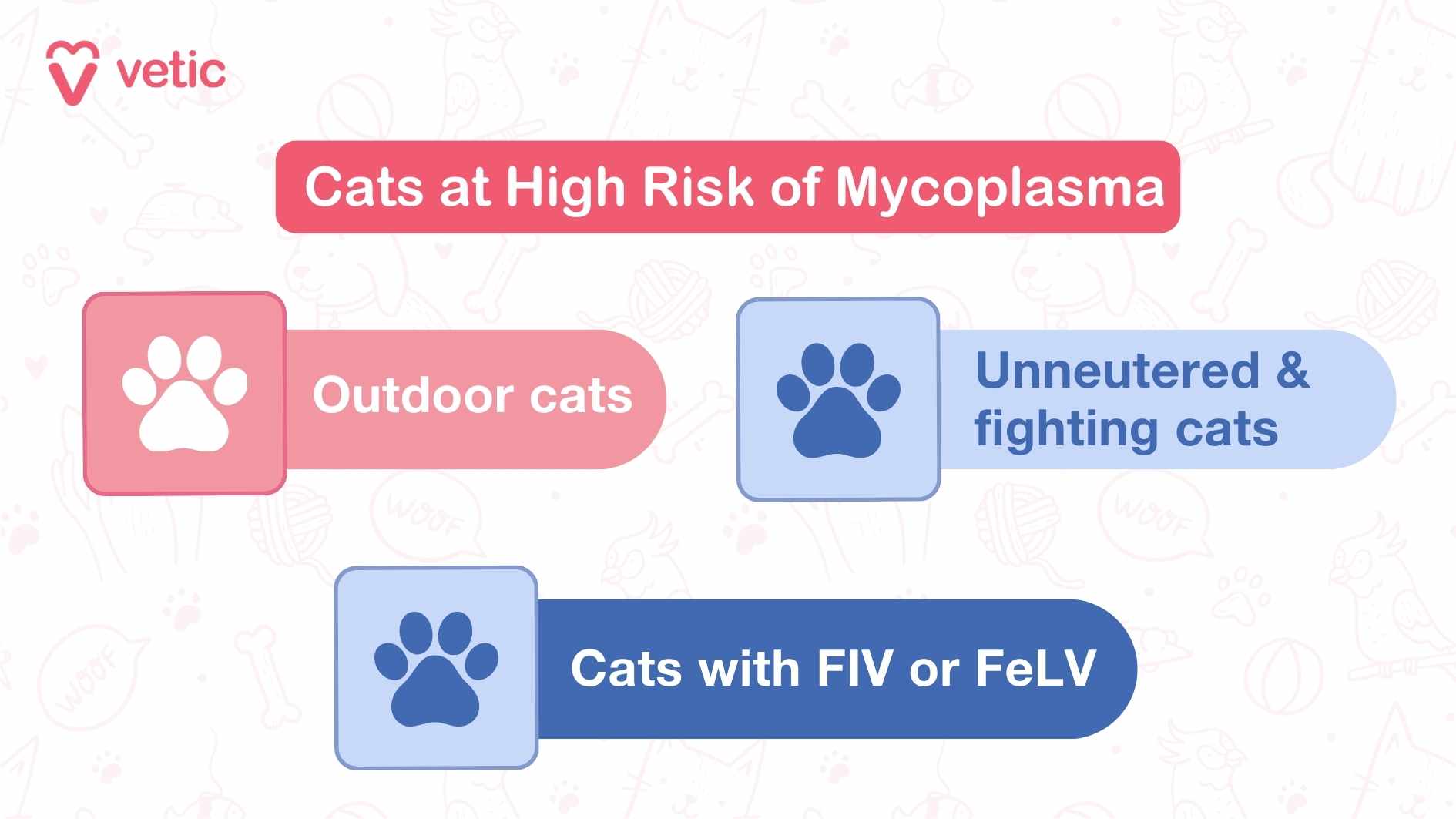
Cats who are incompletely vaccinated, live outdoors or not neutered and get into frequent fights with other cats are at the highest risk of mycoplasma infection.
Cats with feline immunodeficiency virus (FIV) or feline leukemia (FeLV) are also at higher risks of developing the clinical signs and symptoms of mycoplasmosis in cats.
Prevention of Mycoplasma in Cats
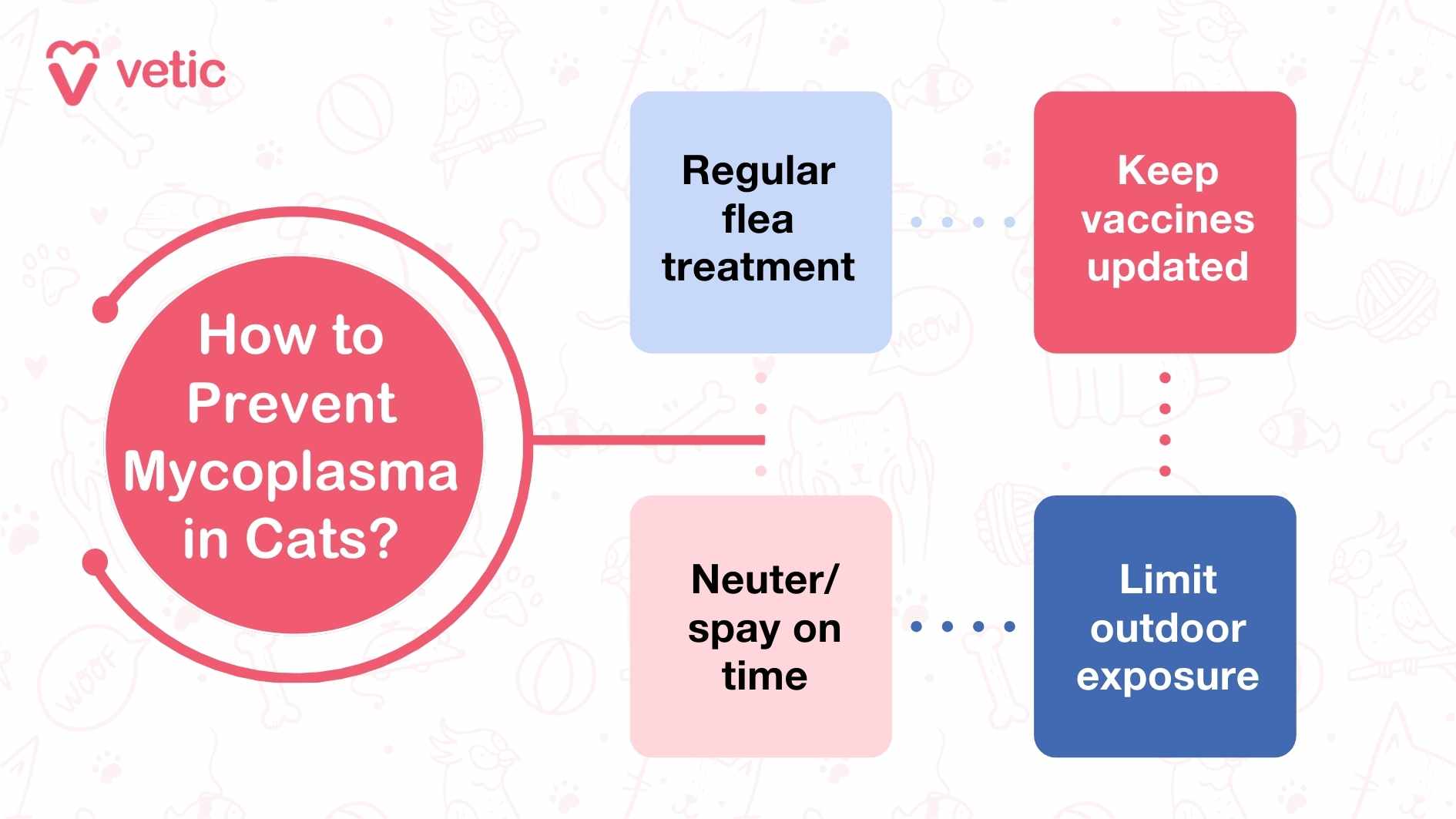
There is no vaccine or medicine to prevent mycoplasma infection in cats.
However, there are a few steps you can take to keep your cats safe –
- Apply flea treatment as per vet recommendation
- Keep their vaccines and deworming updated
- Neuter/spay them on time
- Restrict their movement outdoors
If you have outdoor cats, speak with your veterinarian about how to keep them as well as your indoor cats safe from fleas and mycoplasmosis.

